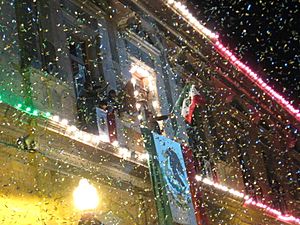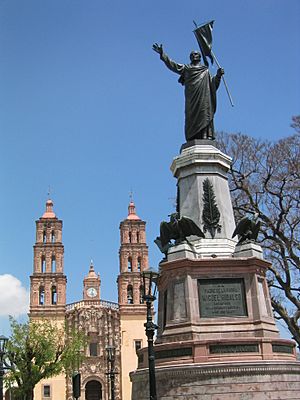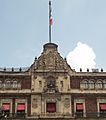Grito de Dolores facts for kids
The Grito de Dolores (which means "Cry of Dolores") was a very important speech given by Father Miguel Hidalgo y Costilla. He was a Catholic priest. He gave this speech on September 16, 1810. It happened in the small town of Dolores, which is why it's called the "Cry of Dolores."
People also call it the Grito de la Independencia, or the Cry of Independence. It was a call for Mexico to become free from the Spanish government. Spain was having big problems because of a war in Europe at that time.
The Start of the Fight
Hidalgo and a group of people called criollos were secretly planning to fight the Spanish rulers. Criollos were people born in Mexico but with Spanish parents. Their plans were discovered, and they were in danger.
Hidalgo was worried about being arrested. So, on the night of September 15, he sent his brother Mauricio and other armed men to the local sheriff. They made the sheriff release people who wanted Mexico to be independent. They freed eighty prisoners that night.
The next morning, around 6:00 am, Hidalgo rang the church bells. He gathered everyone who attended his church. With Ignacio Allende and Juan Aldama by his side, he spoke to the crowd. He encouraged them to rise up against the Spanish Viceroy, who was the main ruler in Mexico. What he said exactly is still debated by historians.
Just four days later, the Battle of Guanajuato happened. This was the first big fight of the war. Mexico did not become fully independent from Spain until September 27, 1821. This was after ten years of fighting.
Remembering the Grito

Every year on the night of September 15, the President of Mexico rings a bell at the National Palace in Mexico City. This happens around eleven in the evening. After ringing the bell, the president gives a patriotic speech called a Grito Mexicano. This speech is based on Hidalgo's original "Grito de Dolores."
The president calls out the names of important heroes from the Mexican War of Independence. He ends by shouting "¡Viva Mexico!" three times from the palace balcony. After the shouts, he rings the bell again and waves the Flag of Mexico. The crowd in the Plaza de la Constitución cheers loudly. Then, everyone sings the Himno Nacional Mexicano, which is Mexico's national anthem.
On the morning of September 16, which is Independence Day, a national military parade takes place. It starts in the Zócalo (another name for the Plaza de la Constitución). The parade passes the Hidalgo Memorial and finishes on the Paseo de la Reforma, Mexico City’s main street.
Similar celebrations happen in cities and towns all over Mexico. Mexican embassies and consulates around the world also hold these events. A local mayor, governor, ambassador, or consul will take on the president's role. They ring bells and give a speech.
In the 1800s, Mexican presidents started visiting Dolores Hidalgo in their last year in office for the Grito de Dolores. President Calderón went to Dolores Hidalgo in 2010. This was part of the bicentennial celebrations, marking 200 years since the Grito.
September 16 is Mexico's Independence Day. It is a special patriotic holiday, or fiesta patria. People celebrate with parades, patriotic events, and music competitions.
Images for kids
-
President Enrique Peña Nieto at the National Palace balcony during the Grito Mexico, D.F., 15 September 2013
-
Felipe Calderón Hinojosa gives the Grito on the main balcony at the National Palace during the bicentennial, in Mexico City the night of 15 September of 2010.
See also
 In Spanish: Grito de Dolores para niños
In Spanish: Grito de Dolores para niños








